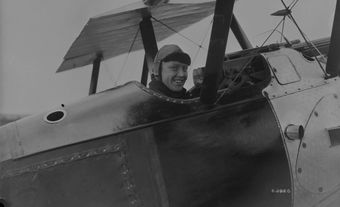Charles Gagnon
Charles Gagnon, painter, photographer and filmmaker (b at Montréal 23 May 1934; d there 16 Apr 2003), was one of the most important and inspiring figures in Québec and Canadian art of the 20th century. With many different areas of interest constantly nourishing his art, he built an original, complex, remarkably consistent body of work. Gagnon was also one of the few Canadian multi-disciplinary artists of his generation: the eclecticism of his work - expressing a real curiosity, an "attitude," a certain way of being in the world - reflects the wide range of his interests (philosophy, music, mathematics, astronomy, etc). As well, his engaging yet demanding art shows genuine regard for the viewer. It is at once cerebral and sensual, open and dynamic, with occasional flashes of humour - qualities that underlie the entire approach, both artistic and philosophical, of his work.From 1955 to 1960, Charles Gagnon lived, studied and worked in New York. During those years, stimulated by the effervescent cultural life of the city, he regularly pursued painting and photography. On his return to Montréal, he began to produce collages and box-constructions in addition to his paintings; this is known as his "landscape" period. Next, two identically titled pieces (La Fenêtre / The Window, 1962) explored a complex spatial ambiguity, about the figure of the square, in particular. The concept of these works is essential to understanding those that followed, which took on a more experimental character as Gagnon delved into such notions as contrasting surfaces, materials (stainless steel, aluminum, etc.) and even the relationship between painting and sculpture. He also carried out a silkscreen project, became interested in sound (producing a series of audio collages), then went on to tackle experimental film and made three movies (including Le Huitième Jour / The Eighth Day, 1966, presented as part of the program of the Christian Pavilion at EXPO 67, for which he designed the building as well). After that, except for a brief interlude in the early 1970s, his painting can be seen as falling within a series of major periods: from the "white paintings" (1967-1969), to the Markers / Marqueurs (1973-1974), the Splitscreenspace series (related to the mural Time-Screen, Thought-Space, Ottawa, 1975, a tribute to former Prime Minister Lester B. PEARSON), Cassations, Inquisitions (1976 to 1983) and the "word paintings" (1986 to 1990). Gagnon's photography, which remained an interest of his throughout these years, also featured a number of key moments, such as the SX 70 and Minox works of the late 1970s. All through the 1990s, photography (Tables de matière and Mythes) and painting (États et conditions) were alternately the focus of his efforts, until they inevitably came together in an innovative, fruitful dialogue, with works combining both mediums (Histoires naturelles and Ex Situ).
In 2002 Charles Gagnon was the recipient of a Governor General's Visual and Media Arts Award.

 Share on Facebook
Share on Facebook Share on X
Share on X Share by Email
Share by Email Share on Google Classroom
Share on Google Classroom


